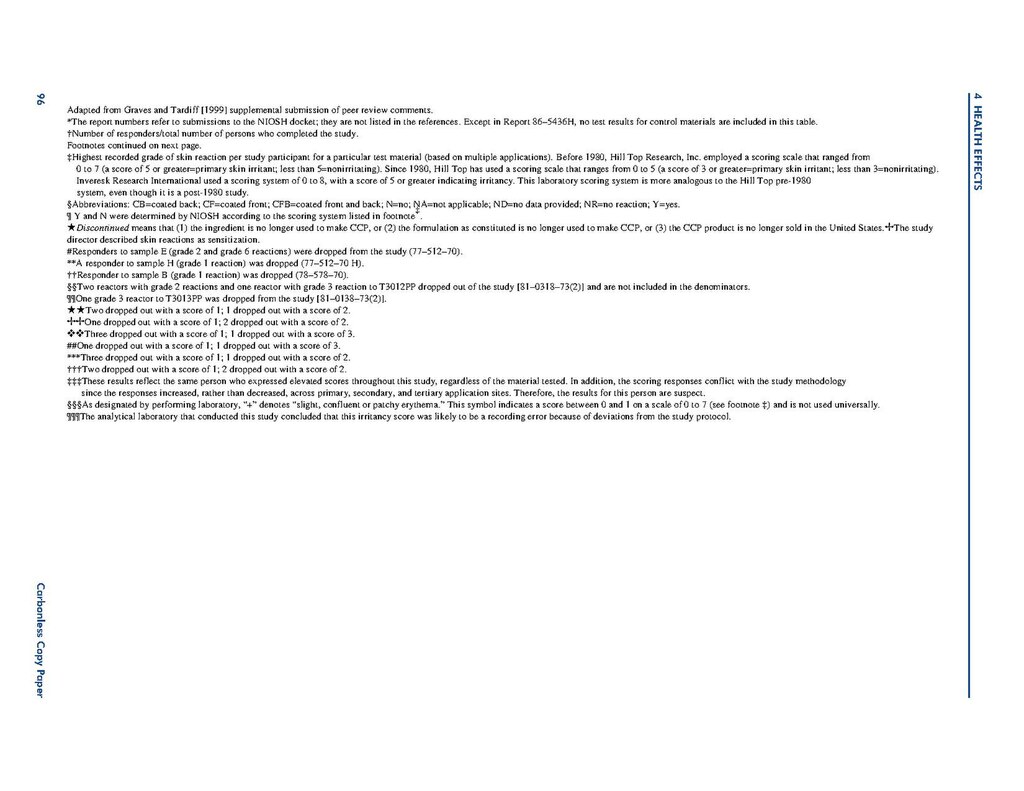There was a problem when proofreading this page.
4 HEALTH EFFECTS
Adapted from Graves and Tardiff [1999] supplemental submission of peer review comments.
† [2] Footnotes continued on next page.
‡ [3]
§ [4]
¶ [5]
†† [10]
§§ [11]
¶¶ [12]
††† [18]
‡‡‡ [19]
§§§ [20]
¶¶¶ [21]
96
Carbonless Copy Paper
- ↑ The report numbers refer to submissions to the NIOSH docket; they are not listed in the references. Except in Report 86–5436H, no test results for control materials are included in this table.
- ↑ Number of responders/total number of persons who completed the study.
- ↑ Highest recorded grade of skin reaction per study participant for a particular test material (based on multiple applications). Before 1980, Hill Top Research, Inc. employed a scoring scale that ranged from 0 to 7 (a score of 5 or greater=primary skin irritant; less than 5=nonirritating). Since 1980, Hill Top has used a scoring scale that ranges from 0 to 5 (a score of 3 or greater=primary skin irritant; less than 3=nonirritating). Inveresk Research International used a scoring system of 0 to 8, with a score of 5 or greater indicating irritancy. This laboratory scoring system is more analogous to the Hill Top pre-1980 system, even though it is a post-1980 study.
- ↑ Abbreviations: CB=coated back; CF=coated front; CFB=coated front and back; N=no; NA=not applicable; ND=no data provided; NR=no reaction; Y=yes.
- ↑ Y and N were determined by NIOSH according to the scoring system listed in footnote ‡.
- ↑ Discontinued means that (1) the ingredient is no longer used to make CCP, or (2) the formulation as constituted is no longer used to make CCP, or (3) the CCP product is no longer sold in the United States.
- ↑ The study director described skin reactions as sensitization.
- ↑ Responders to sample E (grade 2 and grade 6 reactions) were dropped from the study (77–512–70).
- ↑ A responder to sample H (grade 1 reaction) was dropped (77–512–70 H).
- ↑ Responder to sample B (grade 1 reaction) was dropped (78–578–70).
- ↑ Two reactors with grade 2 reactions and one reactor with grade 3 reaction to T3012PP dropped out of the study [81–0318–73(2)] and are not included in the denominators.
- ↑ One grade 3 reactor to T3013PP was dropped from the study [81–0138–73(2)].
- ↑ Two dropped out with a score of 1; 1 dropped out with a score of 2.
- ↑ One dropped out with a score of 1; 2 dropped out with a score of 2.
- ↑ Three dropped out with a score of 1; 1 dropped out with a score of 3.
- ↑ One dropped out with a score of 1; 1 dropped out with a score of 3.
- ↑ Three dropped out with a score of 1; 1 dropped out with a score of 2.
- ↑ Two dropped out with a score of 1; 2 dropped out with a score of 2.
- ↑ These results reflect the same person who expressed elevated scores throughout this study, regardless of the material tested. In addition, the scoring responses conflict with the study methodology since the responses increased, rather than decreased, across primary, secondary, and tertiary application sites. Therefore, the results for this person are suspect.
- ↑ As designated by performing laboratory, "+" denotes "slight, confluent or patchy erythema." This symbol indicates a score between 0 and 1 on a scale of 0 to 7 (see footnote ‡ />) and is not used universally.
- ↑ The analytical laboratory that conducted this study concluded that this irritancy score was likely to be a recording error because of deviations from the study protocol.
